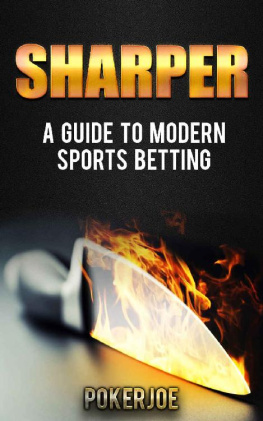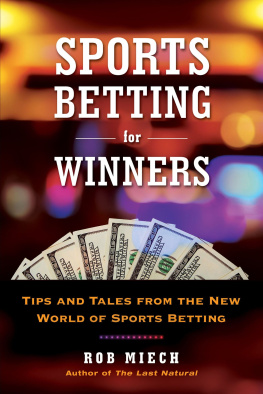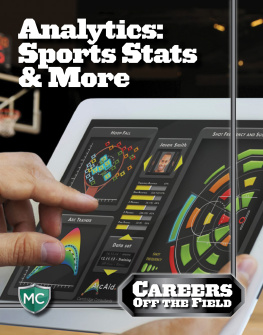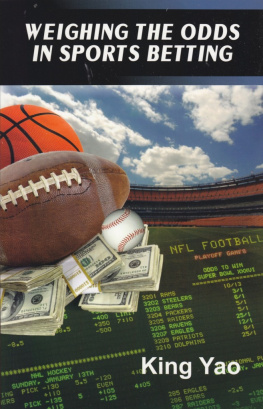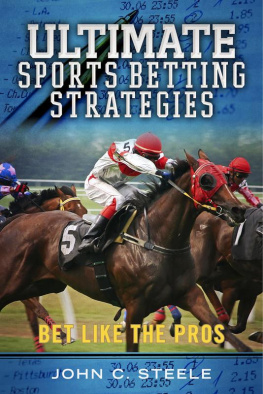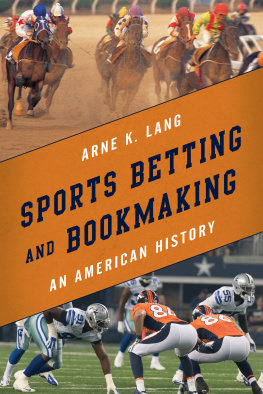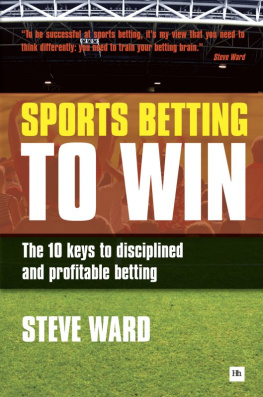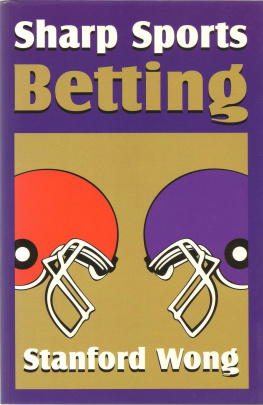SHARPER
A Guide to Modern Sports Betting
True Pokerjoe
Copyright 2016 Richard Bennet
All rights reserved
The characters and events portrayed in this book are fictitious. Any similarity to real persons, living or dead, is coincidental and not intended by the author.
No part of this book may be reproduced, or stored in a retrieval system, or transmitted in any form or by any means, electronic, mechanical, photocopying, recording, or otherwise, without express written permission of the publisher.
ISBN-13: 9781520109329
ISBN-10: 1477123456
Cover design by: Art Painter
Library of Congress Control Number: 2018675309
Printed in the United States of America
Contents
Preface
Feedback on this book has been overwhelmingly positive, especially the off-the-record comments from the very few people who are true professional sports bettors. And I am inordinately happy about this public review:
https://tinyurl.com/ycwvewgu
There have, however, been a few bad ratings on Amazon by people upset that this book contained math and, even worse, didnt tell them who to bet on.
This isnt Sports Betting for Dummies and I wont apologize for these problems. Sharp sports betting entails a little math. You dont have a long run chance of winning without doing some calculating.
As to who to bet on, let me remind you of this basic truth: no one can give you winners. Sports betting is a market. That means, if someone publicizes an easy system, even if it was originally profitable, its edge will be absorbed into the prices.
Many players pay someone, a tout or a system-seller, for plays. They think that there are such great handicappers in this world that you, tailing them, can cover the juice and their fees.
Im always impressed that there are people who can beat the juice. But to beat the juice and the touts fee? If you find such a person, youre right, you dont need no damn math. Stop reading this free book sample and just ride that gravy train, you lucky bastard.
Many of you have jobs and the last thing you want to do when you come home is more work. You want to bet some ball games and enjoy watching them. That is absolutely fine, sports betting for most people should be entertainment.
Yet you should still buy this book because even a very little sports betting math will save you a lot of money in the long run; being able to intelligently choose, for example, between betting a team at -7 +100, -7.5 -110, or -8 -120, when you have the choice of lines, adds up.
And just learning how to properly play all the new account bonuses the sports books are offering is worth thousands of dollars, and I cover that in the addendum at the end of this book.
But if you do want to work at this? This book is a careful explanation of the undeniable and calculable truths of sports betting , and a point in the right direction for sports handicapping .
If you make your own numbers, that is, if you actually handicap, you have to understand that a game in which your ratings make a team a 6 point favorite in a game where theyre favored by only 3, you dont necessarily have a 3 point edge, even if your ratings are right. Youll learn why you should bet one amount if youre laying -3 but the sharp market line is -3.5, a lesser amount if the sharp line is -3, and why you should probably pass altogether if the sharp line is -2.5, even though in all three instances you thought the line should be -6 and could bet at -3!
In parting from this free-book-sample introduction, I am going to give you a system, to make a point.
Its an NFL system based on turnover difference, philosophically sound because anyone who really understands the NFL understands that turnovers are mostly luck:
Bet on a team whose average turnovers margin is 0.75 over its average opponents turnover margin, if they also lost their previous game.
Turnovers margin means turnovers lost; that is, the teams been unlucky.
ATS (against the spread): 472-346-19, 57.7%.
Good result? Here's the thing: t his isnt handicapping.
Handicapping is making your own line .
Theres no projected line coming from this system. Systems unattached to ratings leave you with no idea whether theyve since been incorporated into the line, meaning you have no idea whether you should bet them.
In the above NFL turnover margin system, that great result if from before 2012.
Since then, that same system is 142-148 .
So you can see that the market has incorporated this idea of turnovers regressing to the mean into the price. A system with an 800+ game sample collapsed. If youd married it, you would have lost 20 units on it.
If you are properly evaluating NFL game results, you will not overrate teams which have been lucky with turnovers. Youll gain this system's edge against a market still overreacting to final scores, but without using a simple plug-in system.
The difference is that you wont be betting when the systems impact is already in the line or negated by other factors.
This book isnt about such systems. They have indirect value, but you should not be looking to often bet on them straight out. They are what many people think of as handicapping, but what real sharps dismiss (for outright use, that is).
Hopefully, by the time you finish this book, youll understand what I mean. But first I will, perhaps tediously, make sure you understand the games philosophical fundamentals.
Chapter 1: The Essence
In sports betting, you don't get to watch the pros in action. You almost never even hear from them. The experts on television? They sound like they know what theyre talking about. Thats literally their job: sounding like theyre smart. Looking like it. Or just being good looking.
But real pros don't have speeches to give, stories to tell and reasons to elaborate about their plays, they only have numbers.
In sports betting we dont think in terms of beginners, intermediate and expert players, we think in terms of squares and sharps, recs or pros. You can play this game for years and be square; you can be fairly sharp right from the start if you want.
The essence of recreational sports betting is to have fun rooting for a team or make a game more interesting to watch.
The essence of sharp sports betting is to bet that your estimate of a teams win chance is more accurate than the markets .
I almost said, The essence of professional sports betting, in the line above, but whether you can or even truly want to be a professional Ill deal with later. For now lets discuss how to raise your game so that you are at leastand lets use the games lingosharper.
I'll begin with a review of some basics. Most of you know all this, but bear with me, because sometimes, when you need to retool your game, review.
All bets consist of two parts: a definition and a price.
The definition of a bet might be, for example, that Baltimore will win by more than 2.5 points (or wont) and the price, as stated American style, is -110 (1.91, decimal style).
Juice is what a bookmaker adds to its prices to create its profit. Typically in US sports betting that amount is called ten cents, so that a bookie requires you to bet $1.10 to win $1.00. This juice is typical for US-facing sports books and it means you must win 52.4% of your bets at that price to break-even, which is shockingly hard to do.
Then again maybe it isnt shocking. Point spreads are so accurate that unless you do good work you are essentially flipping a coin, and the juice will break you. In moneyline bets (where there is no point spread/handicap) the odds still equate to a coin flip in that it doesnt much matter (aside from market biases) which team you bet, youll long-run lose the juice.
Sports betting squaresand the vast, vast majority of bettors are terrible squaressuffer a delusion: without calculating anything, they presume that a games odds are wrong. Every time you make a sports bet, if youre not just betting for fun, you should recognize that you are saying the odds are wrong. The difference between a sharp and a square is that the sharp might be non-randomly right.
Next page
